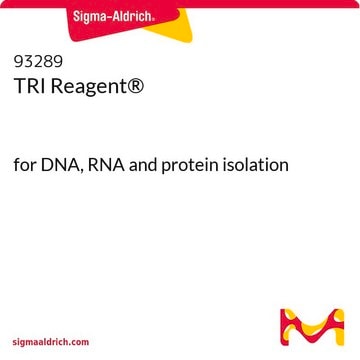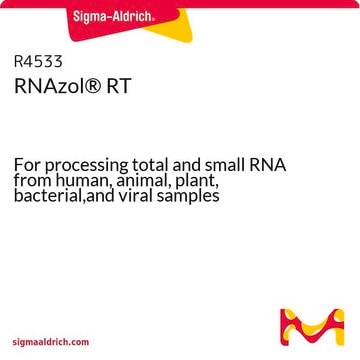B9673
1-Bromo-3-chloropropane
for isolation of RNA
Sinónimos:
1-Bromo-3-chloropropane, I-BCP, Trimethylene bromochloride, Trimethylene chlorobromide
About This Item
Productos recomendados
grade
for molecular biology
assay
≥98.5% (GC)
form
liquid
refractive index
n20/D 1.486 (lit.)
bp
144-145 °C (lit.)
density
1.592 g/mL at 25 °C (lit.)
storage temp.
room temp
SMILES string
ClCCCBr
InChI
1S/C3H6BrCl/c4-2-1-3-5/h1-3H2
InChI key
MFESCIUQSIBMSM-UHFFFAOYSA-N
¿Está buscando productos similares? Visita Guía de comparación de productos
General description
Application
- feline teeth
- mice brain and liver tissues
- human ectocervical epithelial cells
- placental samples
- human mesenchymal stromal cells (hMSCs)
Features and Benefits
- less toxic alternative to chloroform
- compatible with TRI reagent for isolation of RNA with decreased DNA contamination
Other Notes
related product
signalword
Danger
hcodes
Hazard Classifications
Acute Tox. 3 Inhalation - Acute Tox. 4 Oral - Aquatic Chronic 3 - Muta. 2 - STOT SE 3
target_organs
Respiratory system
Storage Class
6.1C - Combustible acute toxic Cat.3 / toxic compounds or compounds which causing chronic effects
wgk_germany
WGK 2
ppe
Eyeshields, Faceshields, Gloves, type ABEK (EN14387) respirator filter
Certificados de análisis (COA)
Busque Certificados de análisis (COA) introduciendo el número de lote del producto. Los números de lote se encuentran en la etiqueta del producto después de las palabras «Lot» o «Batch»
¿Ya tiene este producto?
Encuentre la documentación para los productos que ha comprado recientemente en la Biblioteca de documentos.
Los clientes también vieron
Protocolos
TRI Reagent enables simultaneous DNA, RNA, and protein isolation with sample prep guidelines and troubleshooting.
Method for purification, reverse transcription and quantitative PCR for MicroRNAs using Mysticq reagents
Nuestro equipo de científicos tiene experiencia en todas las áreas de investigación: Ciencias de la vida, Ciencia de los materiales, Síntesis química, Cromatografía, Analítica y muchas otras.
Póngase en contacto con el Servicio técnico












